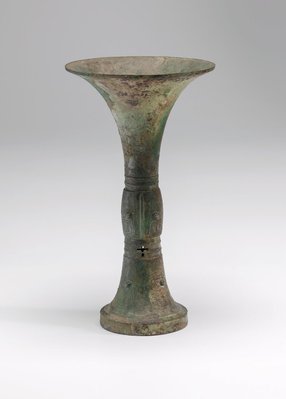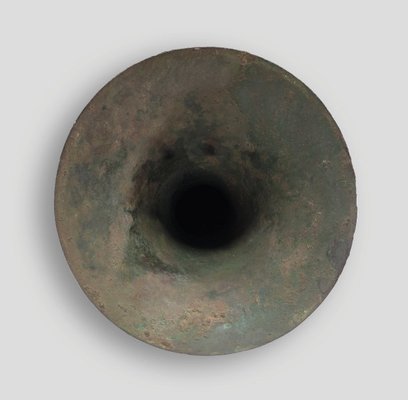

-
Details
- Place where the work was made
-
China
- Period
- Shang dynasty circa 1600 - 1100 BCE → China
- Date
- 1200 BCE-1000 BCE
- Media category
- Metalwork
- Materials used
- bronze with decoration
- Dimensions
- 27.3 x 15.5 cm
- Credit
- Purchased 1968
- Location
- Not on display
- Accession number
- EV5.1968
- Copyright
- Share
-
-
About
Bronzes were the pre-eminent artistic accomplishment of the Shang and subsequent Zhou dynasties. The Shang is the first historical dynasty of China although evidence is emerging that an earlier dynasty, the Xia, heretofore thought to be legendary, did exist. The Shang, one of the oldest tribes of ancient China, was concentrated mainly along the lower reaches of the Yellow River in the Hebei Province.
Shang society was a slave-owning theocracy in which rituals involving sacrifices to the ancestor spirits played an important part. Sacrifices were made not only to the spirits of immediately preceding ancestors. In more important families the origin of the house was traced back to a legendary hero who had founded the clan and sacrifices were made to him also. The ancestor spirits were regularly consulted on problems in this world by means of oracle bones.
Bronzes were made for ritual, military and agricultural purposes. Even in early Shang times fairly large-scale workshops for the bronze-casting industry existed. Bronzes were made by means of the ceramic piece-mould method, a method already well-established in the creation of clay artifacts. Evidence of this method of casting is seen in the joint-lines on pieces and perhaps in the perforations found in the side of 'ku' beakers such as this one, although the exact purpose of these perforations has not been fully ascertained yet. Mould-casting persisted as the main technique for bronze manufacture until about the 5th century BCE when the lost-wax method began to replace it.
From archaeological evidence we know that most ritual vessels were made in sets. Unfortunately the severe damage sustained by burial sites over the centuries has meant very few complete sets have survived intact. From what has been discovered, it is gathered that wine vessels played a dominant role in Shang rituals (Wen Fong (ed), 'The Great Bronze Age of China', New York, The Metropolitan Museum of Art, Alfred A. Knopf, Inc., 1980. p.7). Both the 'ku' and 'jue' (see below) are wine vessels and in Shang graves they have normally been found in pairs, appearing to have been the most universally used ritual equipment. The 'ku' as a type shows great variety regarding quality, decoration and even shape. This piece is a more modest example of its type, its central band of typical Shang decoration comparatively restrained. Both the 'ku' and 'jue' tend to disappear during the Western Zhou period (1027-771BCE).
Jackie Menzies, 'Early Chinese Art', AGNSW, 1983. cat. no. II (illus.).
-
Places
Where the work was made
China
-
Exhibition history
Shown in 2 exhibitions
Early Chinese art, Art Gallery of New South Wales, Sydney, 26 Feb 1983–08 May 1983
Conversations through the Asian collections, Art Gallery of New South Wales, Sydney, 25 Oct 2014–13 Mar 2016
-
Bibliography
Referenced in 3 publications
-
Art Gallery of New South Wales, Art Gallery of New South Wales picturebook, Sydney, 1972, 138 (colour illus.).
-
Jackie Menzies, Early Chinese Art, Sydney, 1983, not paginated. cat.no. II See 'Further Information' for text.
-
Hal Missingham (Editor), Art Gallery of New South Wales Quarterly, Sydney, Apr 1969, cover (illus.).
-
